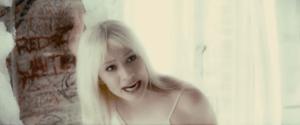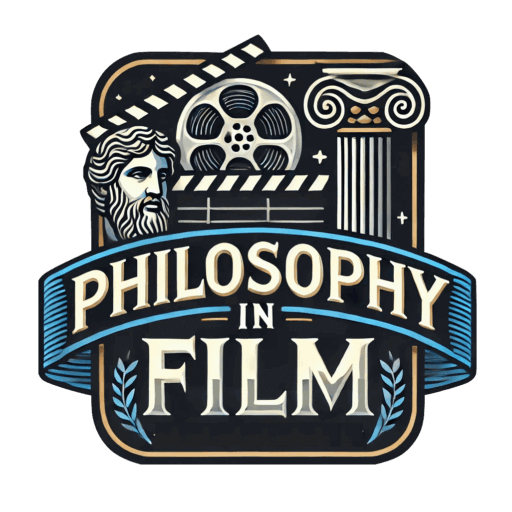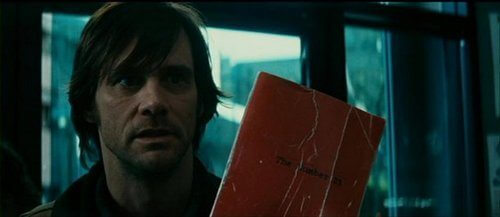Review: The Number 23 (2007) ★½
The Number 23 wants very badly to be a captivating neo-noir crime drama about the power of obsession and paranoia. It draws some inspiration from films such as Darren Aronofsky’s Pi (1998) and Christopher Nolan’s Memento (2000), but sadly director Joel Schumacher lacks the subtlety of style and vision necessary to bring such a story to life. Rather than being a thoughtful, frightening tale concerning the darker side of the human mind, it plays out like a cheap thriller with little to no underlying substance.
Jim Carrey plays Walter Sparrow, a dog-catcher for Animal Control. He is married to Agatha (Virginia Madsen), and they live together with their son, Robin (Logan Lerman). By pure chance (or perhaps by dark forces unknown), Agatha passes by a local bookstore and sees a book entitled “The Number 23” by Topsy Kretts. She decides to purchase it and, after reading it, recommends the book to Walter. Walter begins reading the story, which recounts a detective and his increasing paranoia regarding the “23 enigma,” which is a real conspiracy theory in which all (or most) events and people are somehow connected to the number 23, or to numbers related to 23. Walter quickly sees similarities between himself and the character in the book, and starts seeing instances of the number 23 everywhere he goes. Eventually, the same obsession that the character in the book suffers from overtakes Walter, and his family worries about his sanity as he becomes increasingly isolated and paranoid. Eventually, Walter and his family attempt to find the author of the book, in the hopes that they can uncover the mystery behind the number 23.
I will gladly admit that The Number 23 intrigued me when I first saw the trailer back in 2007, but after seeing nothing but negative reviews, I decided it wasn’t worth my time. More recently, it showed up in my Netflix queue and I decided to take the plunge and watch it, because, despite knowing that it would probably not meet my expectations, I was still intrigued by the premise. I find most films that focus on chronically obsessive or paranoid protagonists to be fascinating, and so I was more than willing to go into The Number 23 with an open mind.

Unfortunately, by the time the story gets interesting, the cracks have already begun to show. Jim Carrey narrates the detective’s story, attempting to fake a raspy, no-nonsense detective voice that is laughably bad. Even though Carrey has proven himself capable of taking on more serious roles time and time again (Eternal Sunshine of the Spotless Mind, The Truman Show, The Majestic), his performance is completely flat in this one. Walter’s character requires an actor who can transition from a seemingly normal, Everyman into a deeply disturbed and paranoid individual. Theoretically, Carrey should have been able to do this, but, for one reason or another (perhaps the awful script), he is completely two-dimensional in The Number 23. None of the other performances are even worth mentioning, as they were either cringe-worthy or completely forgettable.
Part of the problem with The Number 23 is that it lacks a clear direction. It borrows elements from various genres, so much so that it lacks a clear tone. At different moments in the film, it manages to be noir mystery, psychological thriller, dark fantasy, generic horror, and even inadvertent comedy. On top of having a confusing, patchwork tone, it isn’t able to excel as part of any one of these genres. The fantasy elements are never fully explained, the noir detective story is poorly executed and doesn’t match the tone of the rest of the film, and the “horror” is about as boring and ineffective as possible.
It doesn’t help that The Number 23 is so focused on the concept of coincidence. Much of the plot relies on scenarios and chance meetings that are difficult to believe, even within the story’s vaguely surreal framework. So as we are witnessing events that are not very plausible, we are made to contemplate the role that coincidence and plausibility play in life, making the film’s contrivances that much more obvious.
Ultimately, The Number 23 relies far too much on the intrigue of real-life conspiracy theories to carry the plot, and while this works for about the first 20 minutes of the film, it cannot make up for the uneven tone, subpar performances, banal writing, and implausible story. Even if you were to ignore the story, and simply look at its technical accomplishments, they are few and far between. The filmmakers take no chances with the photography, relying on uninteresting staging and cinematography to tell the story as efficiently and blandly as possible. The sequences recounting the detective’s story are given a blurry filter to make them feel more “noir,” but it just makes these parts look cheap and lazy.
If you happen to be interested in the 23 enigma, then you might find The Number 23 worthwhile, otherwise you would be better served to look elsewhere. And even if you’re a fan of Jim Carrey’s more serious work, there are far more entertaining and thoughtful films out there.
Rating: ★½ out of 5
The Number 23 is available to rent or purchase via Amazon here.

